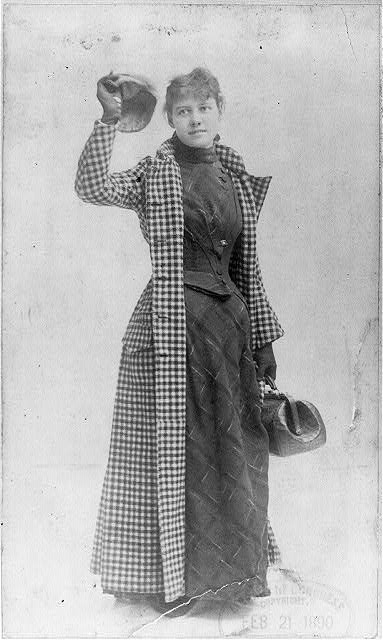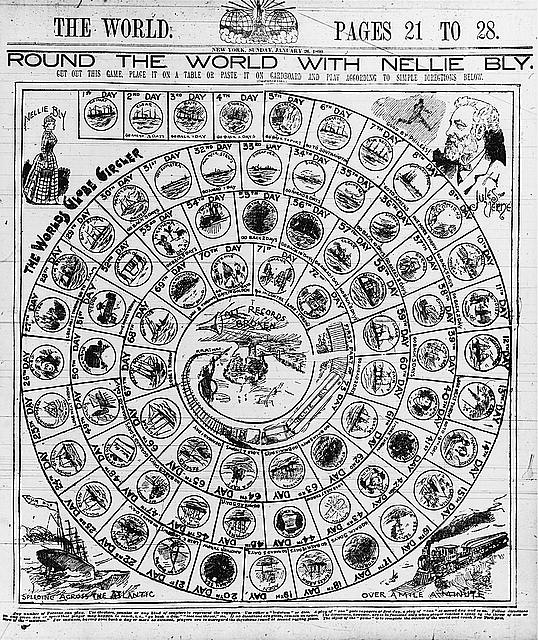Nellie Bly, or Elizabeth Cochrane Seaman, (1864 - 1922) was one of the first prominent female journalists in United States history. Bright, inquisitive, and adventurous, she became a national celebrity while working to improve the lives of vulnerable people. From her early work as an undercover journalist to her globe-trotting adventures, Bly’s life and career are well worth remembering today.
Early Life
Nellie Bly was born Elizabeth Cochrane near Pittsburgh, Pennsylvania in 1864. She came from a large and prominent family, but the death of her father when she was just six cast her future into jeopardy. Bly began to write in to her local paper, the Pittsburgh Dispatch from a young age. There she defended the interests of women in marriage and at work. Her writing impressed editor George Madden so much that he offered her a regular column. She began publishing under the pseudonym “Nellie Bly,” and so her career as a journalist began.
Work in Journalism
Bly’s time at the Pittsburgh Dispatch proved short and frustrating. Bly wanted to be a serious journalist, and she scrutinized the labor conditions of local factories and warehouses. This, of course, was controversial among Pittsburgh’s elite society. Bowing to pressure, the Dispatch placed Bly on more frivolous, “feminine” stories. She spent some time reporting from Mexico, but her comments against President Porfirio Diaz soon forced her to flee the country. Seeking better opportunities, she moved from Pittsburgh to New York City in 1887. But opportunities in New York were few and far between. After months of job searching, she found only one potential job: an undercover dive into the shadowy world of mental institutions.
In the late 1800s, these institutions, particularly for women, saw very little oversight or regulation. At best, they were places where people inconvenient to society were sent to quietly disappear. At worst, they could be mentally and physically abusive to their residents. Rumors of ill treatment had filtered out to the wider world, but no one looked into the issue closely enough to expose more. Enter Nellie Bly and Joseph Pulitzer. Pulitzer, then the editor of the New York World. Pulitzer specialized in in-depth investigation, but the world of women’s asylums remained closed to male reporters.
And so Bly went undercover. Her first task was to be admitted to the asylum. She leased a room at a boardinghouse, skipped a few nights’ sleep, and made strange comments to her neighbors, who quickly grew concerned. Police took Bly into custody, where she faced medical examinations and a court proceeding before being declared mentally unwell and transferred to the Women’s Lunatic Asylum on Blackwell’s Island. There she experienced 10 days of neglect, physical abuse, and unsanitary conditions. Bly found that her fellow inmates were being fed revolting food, denied water, beaten by nurses, injected with morphine, bathed in cold shared water, and forced to sit still on benches for hours at a time. She dropped her act of insanity as soon as she was admitted but found that “the more sanely I talked and acted the crazier I was thought to be.”
After 10 days on Blackwell Island, the New York World secured Bly’s release. Her reporting on the story, later published as Ten Days in a Madhouse, sparked an immediate furor. She is credited with the first waves of asylum reforms, pushing mental institutions to treat their residents with greater humanity and dignity. In addition, Bly’s work paved the way for thousands more female journalists in a traditionally male-dominated field.
Trip Around the World
Her asylum reporting made Bly a national celebrity. While she continued to expose social inequities, she also embarked on more light-hearted adventures. Just two decades after the publication of Jules Verne’s Around the World in Eighty Days, Bly set out on her own globe-spanning journey. She departed New York on November 14, 1889 and traveled alone for most of the trip. Her journey took her through England, France, Egypt, Singapore, China, and Japan, where she caught a ship to San Francisco. A final train journey returned her to New York just a little over 72 days after her departure. That set the current record for global circumnavigation, and her book recounting the adventure became an instant bestseller.
The Legacy of Nellie Bly
Following these high profile stunts, Bly settled down to a quieter life as a reporter, novelist, and later businesswoman and inventor. The outbreak of WWI saw her return to journalism on the front lines of Europe. In her final years, she championed women’s suffrage and lived to see American women gain the vote in 1920. Tragically, just two years later, she died of pneumonia at the age of 57. Today, she is best remembered for her work exposing social ills, as well as her remarkable drive and independence.
Bly, Nellie. Around the World in 72 Days. West Margin Press, 2021.
Bly, Nellie. Ten Days in a Mad-House. BookRix, 2014.
About TOTA
TOTA.world provides cultural information and sharing across the world to help you explore your Family’s Cultural History and create deep connections with the lives and cultures of your ancestors.



